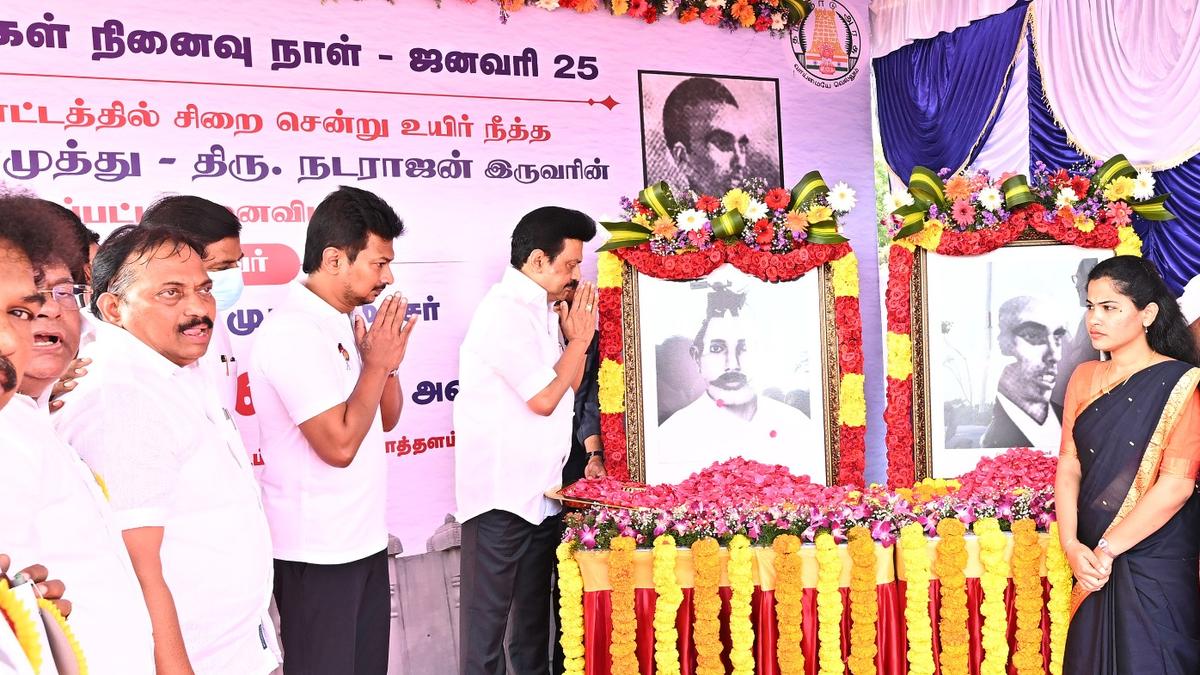Tamil Nadu Chief Minister M.K. Stalin recently unveiled the renovated memorial of Tamil martyrs Natarajan and Thalamuthu, commemorating their sacrifice for the Tamil language in 1939. This powerful tribute highlights a pivotal moment in history and reignites the conversation surrounding the protection of linguistic heritage. The renovation, completed at a cost of ₹34 lakh in Moolakothalam, was inaugurated on January 25th, a day observed as ‘Tamil Mozhi Thiyagigal Naal’ (Tamil language martyrs’ day) by the State government. Chief Minister Stalin's act of paying floral tributes to the martyrs, along with social activist Dharmambal Ammaiyar, beautifully demonstrates respect for those who fought tirelessly against the imposition of Hindi. Beyond the renovation, the announcement of installing statues of Natarajan and Thalamuthu at the Thalamuthu Natarajan Building in Egmore, fulfills the request of VCK president Thol. Thirumavalavan. This decision further cements the heroes’ place in the hearts and minds of the people.
The Fight For Tamil: A Legacy of Linguistic Courage
The 1939 anti-Hindi imposition movement stands as a symbol of unwavering determination to protect the Tamil language and culture against the threat of cultural dominance. Natarajan and Thalamuthu, alongside numerous unsung heroes, bravely stood their ground in defense of their mother tongue. Their ultimate sacrifice serves as a constant reminder of the value of cultural identity and its importance to generations past and future. This struggle was more than just about language; it embodied a fierce opposition to political agendas threatening to dilute their rich cultural heritage and identity. Understanding the depth of their cause underscores the necessity for cultural preservation efforts around the globe, especially in regions facing similar linguistic challenges.
The Martyrs' Impact: A Ripple Effect on Future Generations
The sacrifice of Natarajan and Thalamuthu has reverberated across generations, fueling linguistic preservation movements. Their act inspired countless others to safeguard their cultural identity, highlighting the potent effect a unified stand for language can have. They stood as symbols of resilience in the face of adversity and their story continues to galvanize future advocates in preserving cultural identities globally. Their struggle serves as a timeless example in fighting for the survival of language and resisting forced assimilation.
Honoring the Heroes: Remembering the Sacrifices
The recent renovation of the martyrs' memorial serves as a symbol of ongoing respect for their contribution to Tamil society. The memorial itself is now more than a stone monument, it is a visible reminder of their selfless service and an expression of collective gratitude. The Chief Minister’s tribute underscored this commitment further, emphasizing a continued effort toward respecting linguistic rights and advocating cultural understanding. This project represents much more than simply building a memorial; it embodies an act of remembrance that conveys both tangible and symbolic appreciation for the immense sacrifice that was given.
The Significance of Statues
Beyond the memorial, the installation of statues of Natarajan and Thalamuthu at the Thalamuthu Natarajan Building holds immense symbolic value. This action places the heroes at the forefront, literally, of community consciousness, guaranteeing that their courageous struggle and profound impact will continue to be known. The prominent display acts as a powerful tool for continued cultural education, reminding individuals about the crucial moments and historical struggles they went through in order to preserve and safeguard the richness of the Tamil language. Such acts of public recognition serve not merely as respectful monuments; rather they are dynamic forms of educational memorials.
The Enduring Legacy: Protecting Linguistic Diversity
The events surrounding Natarajan and Thalamuthu's sacrifice are critical reminders about the importance of maintaining linguistic diversity. The protection of individual languages is pivotal for protecting unique cultures and heritages; this act ensures a diversity of viewpoints, traditions, and perspectives for future generations. The legacy of these martyrs’ serves as a poignant inspiration for preservation efforts, emphasizing how integral safeguarding linguistic and cultural heritage is in the fight for equality and tolerance.
Global Implications for Language Preservation
In an increasingly interconnected world, where dominant languages often overshadow less prevalent ones, the story of the Tamil language martyrs acts as an important catalyst for ongoing discussions about the global threat to linguistic diversity. The ongoing struggle in other regions facing pressures of linguistic assimilation underscores a shared challenge faced by numerous cultures around the globe, and inspires us all to champion the importance of diversity for global harmony.
Take Away Points
- The renovation of Natarajan and Thalamuthu's memorial is a powerful tribute to their sacrifice.
- Their fight in 1939 against Hindi imposition continues to inspire language preservation movements globally.
- The installation of statues ensures that their legacy will not be forgotten.
- The story emphasizes the critical importance of safeguarding linguistic diversity and cultural heritage.









